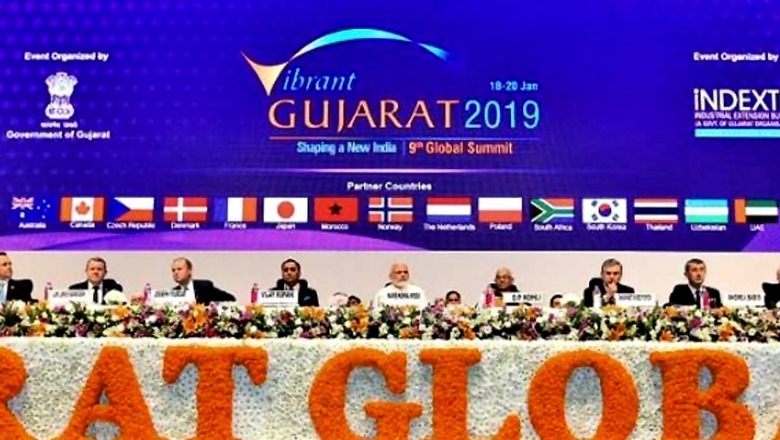
views
With the Vibrant Gujarat Global Summit completing 20 years this year, Prime Minister Narendra Modi will participate in it, commemorating the anniversary.
The 10th edition of the Vibrant Gujarat Global Summit is scheduled for January 2024. From about 300 international participants in 2003, the summit has witnessed an overwhelming participation of up to a 1,000 delegates from over 135 nations.
Today, Gujarat has become a go-to destination for global manufacturers. It ranks second in terms of states receiving the most investments in India, and critical manufacturing projects are all landing in the Western state owing to its strong industrial base, robust infrastructure and widely accessible utilities.
The state is also pioneering India’s march to become a global semiconductor power. In a big move for the country’s upcoming semiconductor industry, US-based chipmaker Micron Technology, Inc. carried out the ground-breaking of its $2.75 billion assembly, testing and packaging plant (ATMP) in Sanand, Gujarat last week. The project marks the largest investment under the India Semiconductor Mission (ISM), an ambitious plan of the Modi government. The deal was finalised during PM Modi’s visit to the United States in June.
Within six days of signing that agreement, the Gujarat government had allocated land and signed the MoU. That’s because Gujarat is the first and so far the only state to have a policy for the semiconductor sector.
It had launched its Semiconductor Policy 2022-27 in July 2022 and by September that year, had received $20 billion (about Rs 1.5-lakh crore) investment jointly by Vedanta and Foxconn for a semiconductor fabrication unit, a display fabrication unit, and a semiconductor assembling and testing unit.
Symphony of Innovation and Infrastructure
As chief minister, Modi had been instrumental in unlocking several factors that have worked to Gujarat’s advantage in the past two decades. Gujarat boasts quality infrastructure, cheap land prices and significant government incentives for manufacturers looking to set up a base.
Besides, Gujarat is a power surplus state, which means there is access to cheap electricity. The state also houses several Special Economic Zones. A nimble bureaucracy and committed political leadership ensured quick decisions have been taken to expand the industrial base.
In FY23, Gujarat emerged as the second most popular destination for investments after Uttar Pradesh, with Rs 37,317 crore in bank-assisted investment proposals. Gujarat’s success in attracting investments has been attributed to the state’s adequately developed infrastructure and effective workforce.
There have recently been some big-ticket investments that have come Gujarat’s way recently.
• Consumer goods major Procter and Gamble India is to invest Rs 2,200 crore in a personal healthcare manufacturing facility at Sanand.
• Dubai-owned ports giant DP World will invest around $510 million to build a new container terminal at the Kandla port in the Indian state of Gujarat
• LBTex Pvt. Ltd. will be investing Rs 450 crore in a textile unit at Kerala GIDC of Ahmedabad, which will lead to the creation of approximately 1,000 jobs.
• The government of Gujarat has signed an MoU with Mascot South Asia LLP for establishing an industrial park across 155 hectares in the Manpura area of Mandal taluka. With an investment of Rs 288.75 crore, this park is projected to create 2,000 jobs.
• A separate MoU has been signed for a proposed joint venture project of Pacem Umashree Pvt. Ltd. and a Brazilian company for the recycling of PET bottles. The project aims to manufacture FIBC jumbo bags and entails an investment of Rs 161.78 crore.
Industry Friendly Gujarat Races Ahead
Just how industry friendly Gujarat is can be seen from how its automobile manufacturing industry has gone from zero to hero. Today, Gujarat’s automobile sector is valued at $3 billion and boasts some key players.
• In Sanand, the establishment of the Tata Motors manufacturing plant in 2009 proved to be the trigger for more automobile manufacturers flocking to Gujarat.
• This was subsequently followed by Ford Motors’ Rs 5,000 crore investment in their Sanand plant in 2011, which generated 3,000 jobs.
• Suzuki Motors set up a Rs 14,784 crore manufacturing plant in 2014 which created 9,100 jobs. Popular modes such as the Suzuki Swift, Dzire and Baleno are manufactured at this plant.
• Automotive tyre giant CEAT set up its Halol plant in 2010 after an investment of Rs 700 crore.
• In 2016, both Honda Motorcycles and Scooters India (HMSI) and Hero MotoCorp, set up manufacturing plants in Gujarat.
• Last year, JCB inaugurated its 44-acre plant in Halol. This plant was built after an investment of 100 million pounds by UK-based JC Bamford Excavators.
• Tata Motors also recently acquired Ford India’s plant for Rs 725 crore. Tata Motors plans to build its electric vehicles, such as the Tiago EV and the Nexon EV at this facility and could also venture into battery cell production at the same location. The state government has also signed an MoU with the Tata Group, worth Rs 13,000 crores, to establish an EV battery plant.
Double Engine of Development
Interestingly, the rise of the automobile sector in Gujarat is a direct consequence of the state attracting manufacturers under the umbrella of the Vibrant Gujarat Global Summit. Credit for much of Gujarat’s industrial success goes to the way the state has been projected nationally and internationally as a region which welcomes businesses and manufacturers with open arms.
Gujarat has done spectacularly in pushing the perception helping manufacturers set up base without hassles, incentivising them and ensuring they have all infrastructure and amenities required to conduct operations seamlessly.
As India looks to become the manufacturing hub of the world, and a major counter to China – Gujarat can become a role-model for other states who are lagging in industrial development and foreign investments. It also proves how alignment between the Centre and state governments can work wonders. Investors are more likely to put their money in states, which have friendly and transparent industrial policies that incentivise businesses instead of making life difficult for them.
















Comments
0 comment